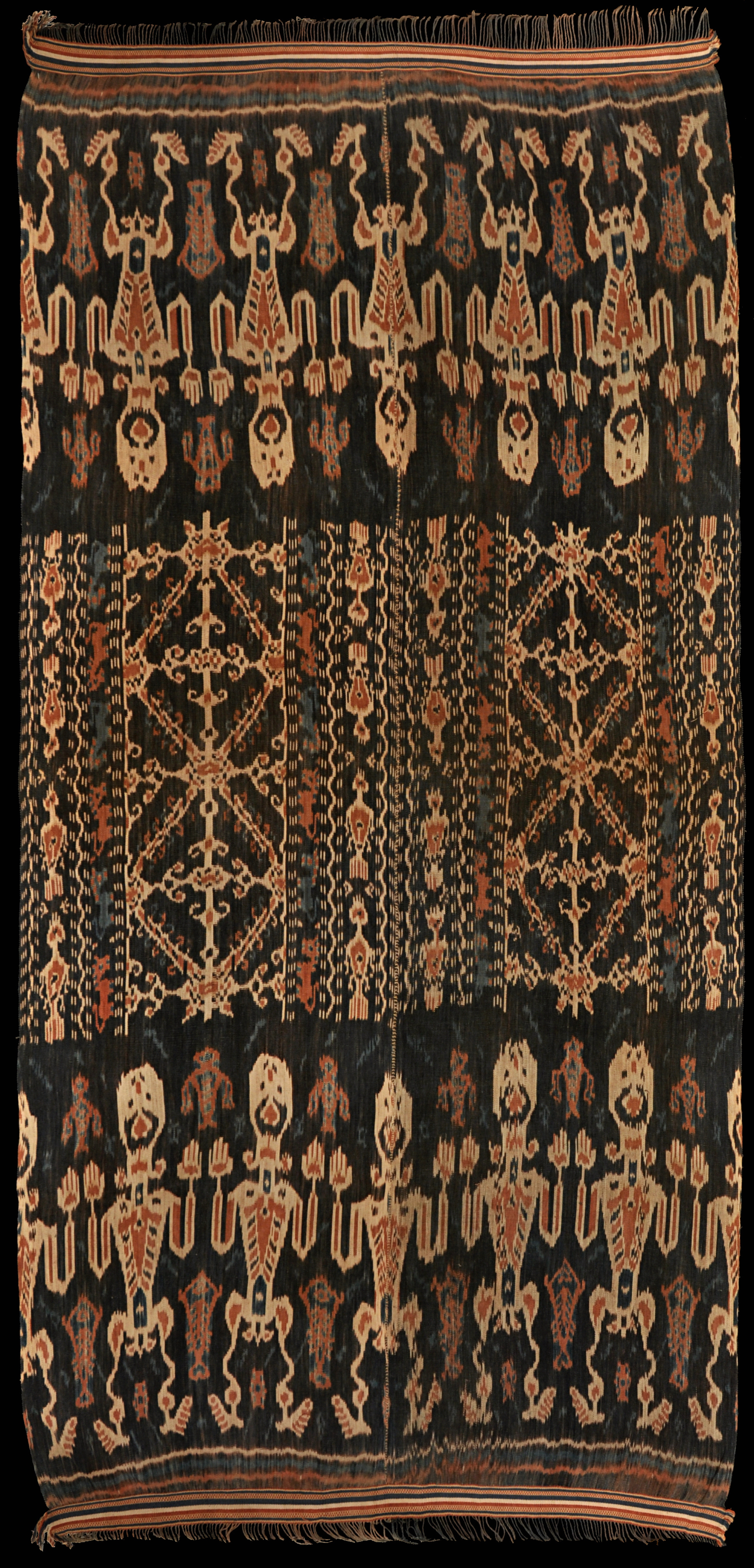| |
 mouse over to magnify mouse over to magnify
| | | | 015 Sumba, East Sumba
Hinggi (men's blanket)
| | Locale: | Kanatang or Kapunduk | | Period: | Early 20th c. | | Panels: | 2 | | Design: | Large male figures with upraised hands, almost certainly representing ancestors, with pronounced genitals, ribcages showing. The lateral protrusions on the genitals may represent testicles, but more likely penis inserts, a type of decoration embedded in the skin that used to be common among Sumbanese noblemen. Animals, perhaps representing birds in flight, parrots, horses, fishes. The central part has motifs called patola maramba, which was inspired by patola of the Vohra Bhat type. Main motifs stand out in white and brick red on black background. True lima varna: yellow not touched in, but ikated. | | Size: | 136 x 274 cm (53.5 x 107.8 in) | | Weight: | 965 g (259 g/m2) | | Yarn: | Cotton, hand-spun, fine, double-ply. quad-ply weft. | | Comment: | Antique Sumba hinggi with the vertically divided midfield that Adams saw mostly in hinggi from her Standard Period, 1904-1912. Colours somewhat faded. The fact that the fifth colour, yellow, was added by the ndata process (applied on sections of warp during the weaving) rather than daubed in after the weaving is indicative of royal status. So are the horses and aquatic animals. The very dark tonality seen in this cloth went out of fashion in the late 1800s and had practically disappeared by 1900 partly as a result of European tastes that influenced Sumbanese weavers. Likely Mangili provenance based on comparison with very similar but substantially larger hinggi in collection Georges Breguet that was made for the raja of Mangili. Traditionally, the patola maramba motif was the prerogative of the royal court of Kanatang. Pattern may have moved into Mangili through marriage. Heavy cloth with a ribbed feel due to unusual quadruple weft. | | Background: | Additional information in chapters on Sumba and East Sumba. | | Published: | Woven Languages, 2014.
Ikat Textiles of the Indonesian Archipelago, 2018.Ikat from Timor and its Outer Islands, 2022.
Noble Virtuosity: Hidden Asymmetry in Ikat from Sumba, 2024. | | Sources: | Nearly identical to hinggi in Langewis and Wagner, Decorative Art in Indonesian Textiles, Plate 1. Similar to 19th C. hinggi depicted in Ten Kate's 1894 Verslag Eener Reis in de Timorgroep en Polynesië, Plate 12, 17. Similar to late 19th - early 20 th C. hinggi in Reedijk c.s., Decorative Arts of Sumba, Pages 76-77. Similar male figures on hinggi from around 1900 depicted in Khan Majlis, Indonesische Textilien, Fig. 413 and 414, both also showing penis inserts. See also hinggi from around 1910 in Khan Majlis, supplement to Gisela Voelger c.s. Indonesian Textiles, Fig. 151, similar figures but without penis inserts. Origin identified by Kinga Lauren. | | |
 ©Peter ten Hoopen, 2025
All rights reserved.
|
|


